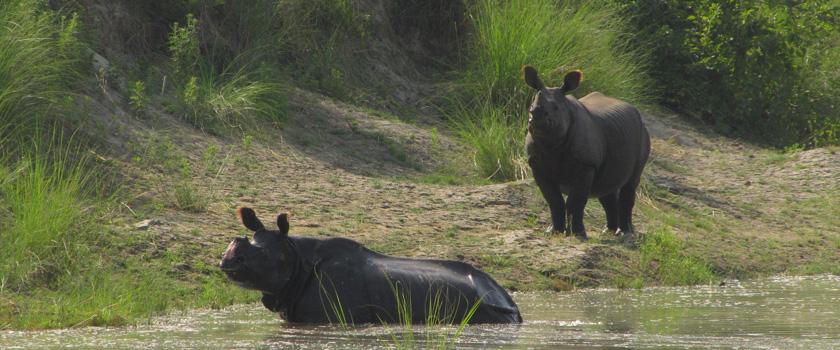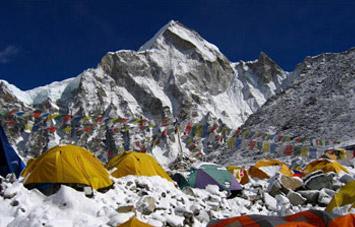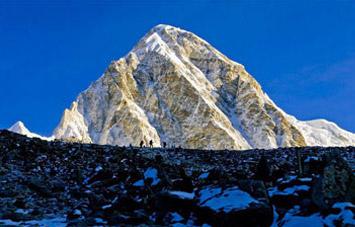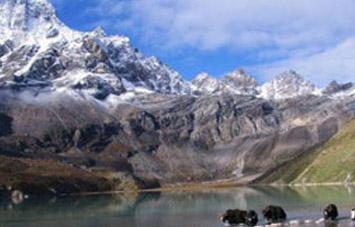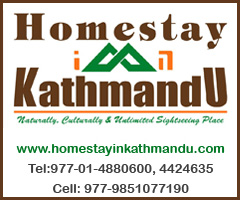Rara & Khaptad National Park
Overview
Trip Information
Rara National Park and Khaptad National Park are two important protected sites in mid and far-western Nepal. This new route aims to link two of Nepal's tourist destinations that are still shadow despite having immense potential. The journey begins with a flight to Talcha Airport in Mugu from Nepalgunj which is easily accessible from Kathmandu via land and aerial routes.
Detail Itinerary
Day 1 (Kathmandu-Nepalgunj)
Nepalgunj can be reached after a flight of 50 minutes from Kathmandu. Regular bus services are also available between the two cities. There are a few good hotels in Nepalgunj. While in Nepalgunj, you can visit Bageshwari Temple and Shiva Temple. You can also visit bordering Indian town of Rupaidiya by taking horse drawn carriages.
Day 2 (Nepalgunj-Rara Lake)
Take a flight to Talcha airstrip (2,645m) of Mugu early in the morning. The flight, which offers you views of amazing landscapes of the mid-western region, takes around 45 minutes. There are around five hotels near Talcha airstrip and some more are under construction. Electricity is not available in the area, but hotels have solar lighting system. Enjoy breakfast at one of the hotels and start trek toward Rara Lake. The trek takes around three and half hours. After a walk of just an hour, we can see changes in landscape and vegetation. After a walk of about an hour, we see first view of Rara Lake. The accommodation tonight is at tented camps. As we approach the campsite, the murmuring sound of waves energizes us. The lake is deep blue in color and as we walk we see the color pattern changing. Our accommodation is at the campsite situated at the banks of Rara Lake. Though there is one hotel at the bank of Rara, it would be better to spend the night in tented camps.
Day 3 (Excursion around Rara Lake)
A short hike to Murmatop is possibly the best way to enjoy breathtaking views of Rara – Nepal's largest lake. Along with Rara Lake, Murmatop also offers magnificent view of Kanjirowa Mountains. Trekkers are suggested to take packed lunch with them as there are no good hotels and eateries in Murmatop. The hike, which takes around three to four hours, passes through a small village. It would be better to start downhill walk early as the campsite at the banks of Rara Lake offers beautiful views of sunset. In the evening, trekkers can enjoy moonrise and also see stars reflected in the pristine waters of Rara Lake.
Rara National Park is located in the north-western Nepal -- south of the Himalayan range. It borders Khamalie, Seri, Rara, Karkibada, Shreenaagr, and Pina VDCs of Mugu district and Bumramadi Chaur, Bota Malika, Kanaka Sundari VDCs of Jumla District. Rara Lake is the main feature of the park. The lake was declared a Ramsar site in 2007. It is surrounded by the magnificent conifer forests. During winter, bird lovers can enjoy many migratory birds. In summer, Himalayan flowers surround the lake creating a colorful landscape. The elevation of the park ranges from 2800m to 4039m. Chuchemera peak (4039m), which forms an excellent backdrop on the southern side, is the highest point in the national park. The lake drains to Mugu-Karnali Rive via Nijar Khola.
The lake is surrounded by reeds Narkat (Phragmites), rushes (Juncus) and sedges (Fimbristylis). There are Phytoplanktonic algae and aquatic plants in the lake water. Leathery leaves of Polygonum form oily floating layers and sessile plants (Myriophyllum) cover shallow area of Lake. Some of the noteworthy flora of the catchment are Kutki (Neopicrorhiza scrophulariflora), Satuwa (Paris polyphylla ), Bikh (Aconitum spicatum ), Pakhanbed (Bergenia ciliata), Karkati Shringi (Pistacia chinensis), Jangali Painyu (Prunus carmesina). Birds found in this area are Baikal teal (Anas ormosa), Common Teal (Anas crecca), Gray Heron (Ardea cinerea), Great Egret (Casmerodius albus), Demoiselle crane (Grus vigor) and Heuglin's Gull (Larus heuglini). Other common birds see in the park are snow cock (Teragallis himalayensis ), Chukor partridhes (Alectoris chukor), Impeyan Pheasant (lophophorus impejanus), Kalij pheasant (lophura leucomelana) and Blood Pheasent (Ithaginis cruentus.
Day 4 (Rara Lake- Serkot)
Walk on the fourth day is mostly downhill. We head to toward Khaytad following the Khaytad River. The walk is pleasing as we see different wild animals and birds along the trail. After a walk of about an hour, we reach Majghat (2,374m). There are three teashops along with a health post in Majghat. After leaving Majghat, the walk is mostly downhill until Murma. There are big pasturelands in Murma. You can simply lie down in the pastureland and watch cloud move over your head. We meet locals dressed in their traditional attire. They speak native language which is somewhat similar to Nepali. We can also see people smoking homegrown tobacco in their hookah.
After about couple of hours, we reach Jhaudi Khola for lunch. There are big caves around the lunch site. An hour walk from Jhaudi Khola takes us to Bapani (2,528m). It is a small village inhabited by Bhramins and Chhetris. There are some teashops and lodges in Bopani. After passing a village called Jam (2,173m) through Nigalbot (2,410) and Masane we reach Serkot. Accommodation tonight is at the campsite near a primary school.
Day 5 (Serkot- Jugala)
It would be ideal to have heavy breakfast while trekking on areas like this as we don't know when lunch will be available. From Jugala, the trek progresses toward Ranakot. After a walk of about an hour through, trek progress through Upper Kharka, Lower Kharka and Khadgi Mela to Majchaur (1,825m). Majchaur is a bustling market area with five lodges and many shops shops.
After a walk of about an hour from Majchaur, we reach Paukipani (1,668m). There are a few teashops that serve freshwater fish for snacks as well as lunch. After a walk of about an hour from Paukipani, we reach our lunch site at Bira Bagar (1,527m). Bira Bagar, as the name suggests, lies on the riverbank. After lunch, the trek heads toward Jamisera. We cross many suspension bridges and come across many waterfalls cascading down the hills into the river. We a walk of about two hours through Ratapani, we reach Ama village. Another half an hour walk from Ama village takes us to Rega village. From here, we get the first view of Karnali River. The Khaytad Khola, which we had followed for about three days, meets Karnali River in this village. After a walk of about an hour along the Karnali River, we reach our campsite at Jugala. The campsite offers great view of Karnali River. This is our last camp in Mugu district.
Day 6 (Jugala-Kolti)
After breakfast, we cross the Karnali River on a suspension bridge and enter Bajura district. After a walk of about an hour from Jugala, we reach Chepi (1,209m). Chepi is a small village on the banks of Karnali River. The trek then progress toward Kurane Jugala (1119m) which is a walk of about 45 minutes from Chepi.
After a trek of about two hours form Kurane Jugala, we reach Alange Chaur (1082m). There are a few houses and lodges in Alange Chaur. Another walk of 45 minutes takes us to our lunch site at Chulighat Badhu. From Chulighat, you can cross the Karnali River and enter Kalikot district. After having lunch, we continue our walk along the banks of Karnali River through Chuli Gadh and Badhu Bagar (1134m). After Badhu Bagar, the trek progresses along the banks of Kundana River. A two-hour walk from Badhu Bagar through Badhu Matela (1,240m), Pipal Dali (1.293m) and Raut Badhu, we reach Partola (1,208m). Kolti is another half hour walk from Partola.
Day 7 (Kolti – Parekh Lekh)
The walk on the seventh day is mostly uphill. We pass through Kumarkot (1466m), Ser Katiya, Samal and Ananda Nagar. From Ananda Nagar, we reach Pandusen (2,044m) through Pirekot (1936m) for lunch. Pandusen is one of the commercial centers in Bajura with good hotels, drug stores and schools. Major inhabitants of this village are Brahmins, Chhetris and Sherpas. After lunch at Pandusen, the trek passes through Chadi Pani (2204m), Angau Pani (2302m) and Paurekhe Khad (2544m). There are few tea shops in Paurekhe Khad. The trial is narrow and slippery. After an hour's walk from Paurekhe Khad, we reach the Parkeh Lekh hilltop (2700m) – our accommodation for the day. The place offers panoramic view of the surrounding hills.
Day 8 Parekh lekh – Martadi
The trek today is mostly uphill until Pugi Dami. The trail passes through dense forest offering you the chances of sighting different wildlife and bird species. We cross many rivulets on log bridges. The trek from Pugi Dami is downhill until we reach Damkane (2339). There are a few tea shops in Damkane. After a trek of around three hours from Martadi, we reach our lunch site at Chuti near Kalika Shool. Chuti is a village inhabited mostly by Dalits. There are some Brahmins and Chhetris in Chuti. After lunch, we trek downhill along the Budhi Nandi River to Martdai (1,897). Martadi is the main market area for four districts -- Bajura, Bajhang, Doti and Accham. The market is big and has motorable road which is connected to the national road network. It also has regular power supply. Though there are a few hotels in Martadi, it would be better to stay in tented camps.
Day 9 (Martadi- Dhuralsen)
After leaving Martdai, we reach Goatwall Bata from where we follow the Bauli River to reach Saleghat (1,362m). A half-hour walk from Saleghat takes us to Rapak (1308m). From Rapak, we can reach Bire Khola (1,292m) after a walk of about an hour. The walk is pleasing as we will be able to see beautiful waterfalls on the way. We reach our lunch site, Jadanga (1165m), after a walk of about half an hour from Kurdali Ghat. Jadanga is a small valley with beautiful hills all around. From Jadanga, we reach the Budhi Ganga River on a suspension bridge and reach Tiphad Bazar (1,118m) – a small marketplace with a few teashops and communications facility. After an uphill climb of about an hour from Tiphad Bazar, we reach Amakhot (1,261m). Amakhot, which is seated on top of a small hill, offers beautiful view of Budhi Ganga River. The walk for the next one and half hour passes through beautiful villages. Our destination for the day is Dhurlasen (1,625m). The place has a few tea shops that provide food and lodging facility.
Day 10 (Dhuralsen – Laske Chaur)
The trek on the 10th day passes through dense forest. After a walk of about an hour form Dhurlasen, we reach Khudi Village. Another hour-long walk from Khudi takes us to Surkha Bazaar which is also known as Aatichaur. From here, the trek passes along Dhane Bagar Khola and we reach Buda Bada (1,974m) through Oli Gaun. An uphill climb for an hour takes us to Lama Gaun (2,023m). After crossing Dhane Bagar Khola, we reach Chede Daha (2,159m). It is situated on top of a small hill. An hour walk from Chede Daha talks us to Dogadi village – our lunch site.
Ater lunch, we reach Tham (2,183m) through Rampur (2,053m). Rampur lies on the border of Bajhang and Bajura districts. We leave Bajhang and start trek toward Bajura district. The trail passes through dense forests. Guliya Chaur (2,610m) is the first destination after we leave Rampur. Guliya Chaur is a pastureland and we feel that Khaptad is welcoming us. After a walk of about an hour from Guliya Chaur, we reach Laske Chaur which lies inside Khaptad National Park. Laske Chaur is an ideal site for camping as there are plenty of water sources in the area.
Day 11 (Laske Chaur – Khaptad)
The trek passes through dense forests on the 11th day. As we will be traveling inside the national park, we will be rewarded with the views of different wildlife and bird species. The trek is uphill for one and half hours until we reach the top (3,033m). After a walk of about half an hour from top, we reach Bhalaune Patan (3123m). It is a big grassland surrounded by pine forests. Pulpule (3173m), our lunch site for the day, can be reached after a walk of an hour from Bhalaune Patan. After lunch, the trek passes through grasslands for three hours until we reach the headquarters of the Khaptad National Park. There are excellent campsites near the park headquarters.
Day 12 Khaptad
This is the rest day. The day can be spent by visiting places in and around the park headquarters like the ashram of Khaptad Baba and the temples of Shiva and Ganesh, and Nagdhunga and Kedardhunga in Tribeni.
Day 13 Khaptad- Simalpani
We leave forest area after a walk of around an hour from park headquarters. After walk of around two hours from the park headquarters, we reach Lekhda (2493m). There are some guesthouses and teashops in Lekhda. After a walk of about an hour through Meltadi (1882m), we reach Lamtada – our lunch site for the day. The village gets electricity from Bhangadidgad Small Hydropower project.
After lunch, we cross Sunar village following an irrigation canal. We reach Fulbari after about one and half hours walk from Sunar via Jimkot (1456m). After a walk of about an hour from Sunar, we reach Simalpani – our destination for the day. We camp at the riverside. It's a nice place to take bath.
Day 14 Simal Pani – Tamil
Today is the last day of our trek. After a walk of about two hours form Simpalpani through Jadri Ghat, Aaucheli Bagar, Tala Bagar, Khati and Khairadi, we reach Tamil (1130m). Tamil is our lunch as well as campsite for the day. From Tamil, regular bus services are available to different parts of the country.
Day 15 Tamil – Dhangadi
We board a Dhangadhi-bound bus early in the morning. The bus takes around 10 hours to reach Dhangadhi – the commercial center of the far-western region. Dhangadhi has number of good hotels and lodges.
Day 16 Dhangadi – Kathmandu
Regular flights to Kathmandu are available from Dhangadhi. If you want to take surface transport, regular bus services are available from Dhangadhi to Kathmandu.
What's Included
Included in the Cost
Not Included in the Cost
Trip Fact
- Duration: 16 Day(s)
- Activities: Jungle Safari
- Group size: Min 1
SIMILAR TRIPS
People who viewed this tour also like...




